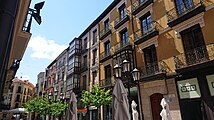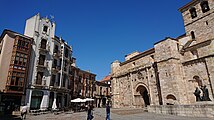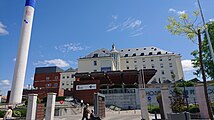Zamora, Spain
Zamora | |
|---|---|
Municipality | |
 Duero river over the city of Zamora. | |
 Flag  Coat of arms | |
 Zamora Location in Spain | |
| Coordinates: 41°29′56″N 5°45′20″W / 41.49889°N 5.75556°W / 41.49889; -5.75556Coordinates: 41°29′56″N 5°45′20″W / 41.49889°N 5.75556°W / 41.49889; -5.75556 | |
| Country | |
| Autonomous community | |
| Province | Zamora |
| Comarca | Tierra del Pan |
| Judicial district | Zamora |
| Government | |
| • Mayor | Francisco Guarido (IU) |
| Area | |
| • Total | 149.28 km2 (57.64 sq mi) |
| Elevation | 652 m (2,139 ft) |
| Population (2016) | |
| • Total | 63,217 |
| • Density | 420/km2 (1,100/sq mi) |
| Demonym(s) | Zamoranos |
| Time zone | UTC+1 (CET) |
| • Summer (DST) | UTC+2 (CEST) |
| Postal code | 49001-49028 |
| Dialing code | 980 |
| Climate | BSk |
| Website | Official website |
Zamora (Spanish pronunciation: [θaˈmoɾa]) is a city in Castile and León, Spain, the capital of the province of Zamora. It lies on a rocky hill in the northwest, near the frontier with Portugal and crossed by the Duero river, which is some 50 kilometres (31 mi) downstream as it reaches the Portuguese border. With its 24 characteristic Romanesque style churches of the 12th and 13th centuries it has been called a "museum of Romanesque art". Zamora is the city with the most Romanesque churches in all of Europe. The most important celebration in Zamora is the Holy Week.
Contents
1 History
2 Main sights
2.1 Surroundings
3 Transportation
4 Climate
5 Notable locals
6 Food
7 Sister cities
8 References
9 Citations
10 External links
History

Cathedral

Castle at night

Aceñas de Olivares (mills on the river Duero)

Santa María Magdalena Church

Sagasta square (modernist buildings)
After the Roman victory over the Lusitanian hero Viriathus the settlement was named by the Romans, Occelum Durii or Ocellodurum (literally, "Eye of the Duero"). During Roman rule it was in the hands of the Vaccaei, and was incorporated into the Roman province of Hispania Tarraconensis. It was on the road from Emerita (modern Mérida) to Asturica Augusta (modern Astorga). (Ant. Itin. pp. 434, 439).
Two coins from the reign of the Visigothic king Sisebuto, show that it was known at the time as "Semure".
During the period of Moorish rule the settlement became known by the names of "Semurah" or "Azemur". After the establishment of the Christian Kingdom of Asturias, the settlement became a strategic frontier post and was the scene of many fierce military engagements between the Muslims and Christians. Control of the town shifted between the two sides a number of times from the early 8th century to the late 10th century. During this period it became heavily fortified.

Old city hall, Plaza Mayor

Romanesque entrance to the Cathedral (12th century)

San Vicente Church
The most notable historic episode in Zamora was the assassination outside the city walls of the king Sancho II of Castile in 1072. Some decades before, king Ferdinand I of León had divided his kingdoms between his three sons. To his daughter, Doña Urraca, he had bequeathed the "well fortified city of Zamora" (or "la bien cercada" in Spanish). All three sons warred among themselves, till the ultimate winner, Sancho, was left victorious. Zamora, under his sister who was allied with Leonese nobles, resisted. Sancho II of Castile, assisted by El Cid, lay siege to Zamora. King Sancho II was murdered by a duplicitous noble of Zamora, Bellido Dolfos, who tricked the king into a private meeting. After the death of Sancho, Castile reverted to his deposed brother Alfonso VI of León. The event was commemorated by the Portillo de la Traición (Treason Gate). Zamora was also the scene of fierce fighting in the 15th century, during the conflict between the supporters of Isabella the Catholic and Juana la Beltraneja. The Spanish proverb, No se ganó Zamora en una hora, literally, Zamora wasn't won in an hour, is a reference to these battles. It is the Spanish equivalent of the English proverb "Rome wasn't built in a day."
During the 12th century, the city was extraordinarily important for its strategic position in the wars between the Kingdom of León and the Almoravids and Almohads. As a result, the city preserves many churches and buildings from that time. In the 1140s and 1150s it was ruled by Prince Ponce Giraldo de Cabrera, who has a street named after him in the city today. In the next centuries, the city lost its political and economic relevance and suffered emigration, especially to South America (where many other cities called Zamora were founded). Henry IV granted Zamora the epithet of "most noble and most loyal city".
During the Spanish Civil War (1936-1939), Zamora was from the start of the military rebellion a nationalist held city. The savagery of the repression against leftists and liberals is captured in Ramón Sender Barayón's 'A Death in Zamora', which tells of the extrajudicial murder of his mother, Amparo Barayon, the wife of the famous novelist Ramon Sender.
Main sights
Main sights of Zamora include:

Torre del Salvador

San Juan de Puerta Nueva Church

San Isidoro Church

The Transit of the Virgin Church

Episcopal Palace

The Peñas de Santa Marta, a rocky plateau at the side of the Douro River on which settled the first inhabitors of the town, with the Cathedral on the left.
Cathedral, in Romanesque style, dating to the 12th century, taking only 23 years to build.- Medieval Castle of Zamora.
Palacio de los Condes de Alba y Aliste, built in 1459 by the first Count of Alva y Aliste. It boasts a patio and staircase decorated with carvings by artists from Lombardy.- Calle Balborraz.
- Church of San Pedro y San Ildefonso, built from the 11th century, probably over a Visigothic temple. It was reformed in Romanesque style in the 12th–13th centuries, but was much renovated in the 15th and 18th centuries. It has presently a single nave with cross vaults
Church of Santa María Magdalena. The southern façade is in Romanesque style, dating back to the 13th century.- Church of San Isidoro (12th century). It has one nave, having a square major chapel. The exterior features two ogival arcades with archivolts.
- Church of San Claudio de Olivares, known from the 12th century. Of small size, it has a single nave with a presbytery and a semicircular apse. The columns of the nave have carvings.
- Church of San Juan de Puerta Nueva (12th century stained glass circular window, symbol of Zamora).
- Church of Santa María la Nueva (12th century, baptistery dating back to the 13th century).
- Church of Santiago de los Caballeros (11th century), located outside the city walls. El Cid was created knight here.
- Church of Santiago El Burgo (Southern façade, 12th century Romanesque)
- City walls: three walled enclosures dating back to the 11th, 12th and 13th centuries.
- Museo de Semana Santa de Zamora: Opposite the Church of Santa María la Nueva, dedicated to Semana Santa de Zamora the processions during which are celebrated with particular ceremony in Zamora. The museum holds a large collection of pasos, the figures which are carried in procession through the streets by various 'cofradías' or brotherhoods. See Holy Week in Zamora

Zamora train station

Viriato street

Balborraz street

San Miguel square

Virgen de la Concha public hospital
Surroundings
Arcenillas church (15th century panels)- Hiniesta church (Gothic, sculptures and murals)
- The Church of San Pedro de la Nave, (village of El Campillo – 12 km distant) was founded in the 7th century, rebuilt in the 12th century, and is one of the three best-preserved Visigothic churches in all of Spain. It was moved stone by stone and then re-erected, owing to the construction of a reservoir on its original site.
Transportation
The city is served by the Zamora Railway Station, located on one of the Spanish North-Northwestern high speed lines.
Climate
Zamora has a cold semi-arid climate (Köppen: BSk), with cool winters and hot summers. Precipitation is mainly recorded in the two seasons, spring and autumn, with summer characterized by droughts.
The highest temperature ever recorded is 41.0 °C on 24 July 1995 while the minimum stood at −13.4 °C on 16 January 1945.
Fog occurring frequently over the winter period, often lasting for days, has tended to lower the average temperature.
| Climate data for Zamora (1981-2010) | |||||||||||||
|---|---|---|---|---|---|---|---|---|---|---|---|---|---|
| Month | Jan | Feb | Mar | Apr | May | Jun | Jul | Aug | Sep | Oct | Nov | Dec | Year |
| Record high °C (°F) | 17.0 (62.6) | 23.5 (74.3) | 26.3 (79.3) | 30.6 (87.1) | 35.0 (95.0) | 39.3 (102.7) | 41.0 (105.8) | 39.2 (102.6) | 38.0 (100.4) | 31.0 (87.8) | 22.6 (72.7) | 20.0 (68.0) | 41.0 (105.8) |
| Average high °C (°F) | 8.3 (46.9) | 11.4 (52.5) | 15.5 (59.9) | 17.1 (62.8) | 21.2 (70.2) | 27.0 (80.6) | 30.4 (86.7) | 29.8 (85.6) | 25.5 (77.9) | 19.0 (66.2) | 12.7 (54.9) | 9.2 (48.6) | 18.9 (66.0) |
| Daily mean °C (°F) | 4.6 (40.3) | 6.4 (43.5) | 9.5 (49.1) | 11.2 (52.2) | 15.0 (59.0) | 19.8 (67.6) | 22.7 (72.9) | 22.3 (72.1) | 18.8 (65.8) | 13.6 (56.5) | 8.4 (47.1) | 5.5 (41.9) | 13.1 (55.6) |
| Average low °C (°F) | 0.9 (33.6) | 1.3 (34.3) | 3.5 (38.3) | 5.3 (41.5) | 8.7 (47.7) | 12.6 (54.7) | 14.9 (58.8) | 14.8 (58.6) | 12.0 (53.6) | 8.3 (46.9) | 4.1 (39.4) | 1.8 (35.2) | 7.4 (45.3) |
| Record low °C (°F) | −13.4 (7.9) | −9.8 (14.4) | −8.4 (16.9) | −4.0 (24.8) | −2.1 (28.2) | 2.4 (36.3) | 5.1 (41.2) | 5.3 (41.5) | 1.2 (34.2) | −4.2 (24.4) | −8.4 (16.9) | −10.6 (12.9) | −13.4 (7.9) |
| Average precipitation mm (inches) | 32 (1.3) | 25 (1.0) | 22 (0.9) | 39 (1.5) | 43 (1.7) | 23 (0.9) | 12 (0.5) | 13 (0.5) | 28 (1.1) | 50 (2.0) | 45 (1.8) | 46 (1.8) | 379 (14.9) |
| Average precipitation days (≥ 1 mm) | 6 | 5 | 5 | 7 | 7 | 4 | 2 | 2 | 4 | 7 | 7 | 7 | 64 |
| Average snowy days | 1 | 1 | 0 | 0 | 0 | 0 | 0 | 0 | 0 | 0 | 0 | 1 | 3 |
| Average relative humidity (%) | 82 | 73 | 63 | 62 | 58 | 51 | 47 | 50 | 57 | 69 | 78 | 82 | 64 |
| Mean monthly sunshine hours | 97 | 144 | 201 | 224 | 264 | 318 | 354 | 322 | 241 | 175 | 113 | 87 | 2,532 |
| Source: Agencia Estatal de Meteorología (AEMet)[1] | |||||||||||||
Notable locals

Medieval bridge over river Duero.
Leopoldo Alas, also known as "Clarín" was a Spanish novelist born in Zamora. A street in Zamora is named after him.
Ángel Nieto: multi-time (or '12+1' as he puts it himself) Grand Prix motorcycle road racing World Champion. He is considered a national hero in his Spanish homeland. The local sports centre is named after him. Some sources mistakenly refer to him as being born in Madrid.
Agustín Remesal: Journalist working as a TVE correspondent. Also writer.
Ramón Álvarez: Born in Zamora. Author of many of the figures or 'pasos' carried through its streets during the Holy Week.
Emilio Merchán: multi-time world champion in canoeing
Carlos Llamas: national radio news presenter, died 10 October 2007.[2]
Food

The covered market.
Food specialties in Zamora include the pulses, the chickpeas or 'garbanzos' from Fuentesauco, the exquisite cheese made from sheep's milk, honey from Sanabria, asparagus from Guareña, peppers from Benavente, steak from Aliste, mushrooms, game, cold meats, cakes and sweets.
Other specialties are the rice dishes from Zamora and the Toro wines (very dark, almost black, nowadays made using modern techniques – with a rapidly growing reputation for their taste and quality).
Traditional dishes include bacalao a la tranca (a cod dish), pulpo a la sanabresa (an octopus dish), dos y pingada (two fried eggs with fried ham, usually served at Easter) and presas de ternera (a beef dish). For dessert there is the rebojo Zamorano, a very tasty though hard type of bun, and las natillas almendradas (Spanish style custard with almonds).
Sister cities
 Bragança, Portugal (1984).[3]
Bragança, Portugal (1984).[3]
 Oviedo, Spain, since 2001.[4]
Oviedo, Spain, since 2001.[4]
 Yaritagua, Venezuela.[5]
Yaritagua, Venezuela.[5]
 Altagracia de Orituco, Venezuela[5]
Altagracia de Orituco, Venezuela[5]
References
 This article incorporates text from a publication now in the public domain: Smith, William, ed. (1854–1857). . Dictionary of Greek and Roman Geography. London: John Murray..mw-parser-output cite.citation{font-style:inherit}.mw-parser-output .citation q{quotes:"""""""'""'"}.mw-parser-output .citation .cs1-lock-free a{background:url("//upload.wikimedia.org/wikipedia/commons/thumb/6/65/Lock-green.svg/9px-Lock-green.svg.png")no-repeat;background-position:right .1em center}.mw-parser-output .citation .cs1-lock-limited a,.mw-parser-output .citation .cs1-lock-registration a{background:url("//upload.wikimedia.org/wikipedia/commons/thumb/d/d6/Lock-gray-alt-2.svg/9px-Lock-gray-alt-2.svg.png")no-repeat;background-position:right .1em center}.mw-parser-output .citation .cs1-lock-subscription a{background:url("//upload.wikimedia.org/wikipedia/commons/thumb/a/aa/Lock-red-alt-2.svg/9px-Lock-red-alt-2.svg.png")no-repeat;background-position:right .1em center}.mw-parser-output .cs1-subscription,.mw-parser-output .cs1-registration{color:#555}.mw-parser-output .cs1-subscription span,.mw-parser-output .cs1-registration span{border-bottom:1px dotted;cursor:help}.mw-parser-output .cs1-ws-icon a{background:url("//upload.wikimedia.org/wikipedia/commons/thumb/4/4c/Wikisource-logo.svg/12px-Wikisource-logo.svg.png")no-repeat;background-position:right .1em center}.mw-parser-output code.cs1-code{color:inherit;background:inherit;border:inherit;padding:inherit}.mw-parser-output .cs1-hidden-error{display:none;font-size:100%}.mw-parser-output .cs1-visible-error{font-size:100%}.mw-parser-output .cs1-maint{display:none;color:#33aa33;margin-left:0.3em}.mw-parser-output .cs1-subscription,.mw-parser-output .cs1-registration,.mw-parser-output .cs1-format{font-size:95%}.mw-parser-output .cs1-kern-left,.mw-parser-output .cs1-kern-wl-left{padding-left:0.2em}.mw-parser-output .cs1-kern-right,.mw-parser-output .cs1-kern-wl-right{padding-right:0.2em}
This article incorporates text from a publication now in the public domain: Smith, William, ed. (1854–1857). . Dictionary of Greek and Roman Geography. London: John Murray..mw-parser-output cite.citation{font-style:inherit}.mw-parser-output .citation q{quotes:"""""""'""'"}.mw-parser-output .citation .cs1-lock-free a{background:url("//upload.wikimedia.org/wikipedia/commons/thumb/6/65/Lock-green.svg/9px-Lock-green.svg.png")no-repeat;background-position:right .1em center}.mw-parser-output .citation .cs1-lock-limited a,.mw-parser-output .citation .cs1-lock-registration a{background:url("//upload.wikimedia.org/wikipedia/commons/thumb/d/d6/Lock-gray-alt-2.svg/9px-Lock-gray-alt-2.svg.png")no-repeat;background-position:right .1em center}.mw-parser-output .citation .cs1-lock-subscription a{background:url("//upload.wikimedia.org/wikipedia/commons/thumb/a/aa/Lock-red-alt-2.svg/9px-Lock-red-alt-2.svg.png")no-repeat;background-position:right .1em center}.mw-parser-output .cs1-subscription,.mw-parser-output .cs1-registration{color:#555}.mw-parser-output .cs1-subscription span,.mw-parser-output .cs1-registration span{border-bottom:1px dotted;cursor:help}.mw-parser-output .cs1-ws-icon a{background:url("//upload.wikimedia.org/wikipedia/commons/thumb/4/4c/Wikisource-logo.svg/12px-Wikisource-logo.svg.png")no-repeat;background-position:right .1em center}.mw-parser-output code.cs1-code{color:inherit;background:inherit;border:inherit;padding:inherit}.mw-parser-output .cs1-hidden-error{display:none;font-size:100%}.mw-parser-output .cs1-visible-error{font-size:100%}.mw-parser-output .cs1-maint{display:none;color:#33aa33;margin-left:0.3em}.mw-parser-output .cs1-subscription,.mw-parser-output .cs1-registration,.mw-parser-output .cs1-format{font-size:95%}.mw-parser-output .cs1-kern-left,.mw-parser-output .cs1-kern-wl-left{padding-left:0.2em}.mw-parser-output .cs1-kern-right,.mw-parser-output .cs1-kern-wl-right{padding-right:0.2em}
Citations
^ Historical records of the Zamora weather station (1971–2000) (in Spanish).
^ "Fallece el periodista Carlos Llamas". ELPAÍS.com. 10 October 2007. Retrieved 28 December 2008.
^ "Una fecha clave – Opinión". La Opinión de Zamora. 21 January 2009. Retrieved 11 March 2011.
^ La Nueva España. "La Nueva España – Diario Independiente de Asturias – Oviedo – Oviedo y Zamora se comprometen a "llenar de contenido" su hermanamiento". Lne.es. Retrieved 11 March 2011.
^ ab "Ciudades y pueblos se benefician del hermanamiento con otros territorios". Larazon.es. Retrieved 11 March 2011.
External links
| Wikimedia Commons has media related to Zamora. |
 Zamora travel guide from Wikivoyage
Zamora travel guide from Wikivoyage- Tourism in Zamora
- Zamora travel guide
- Main festival of Zamora SEMANA SANTA ZAMORA
[permanent dead link] Web page dedicated to the Semana Santa, All content is Creative Commons[permanent dead link]
Entry on planetware.com





